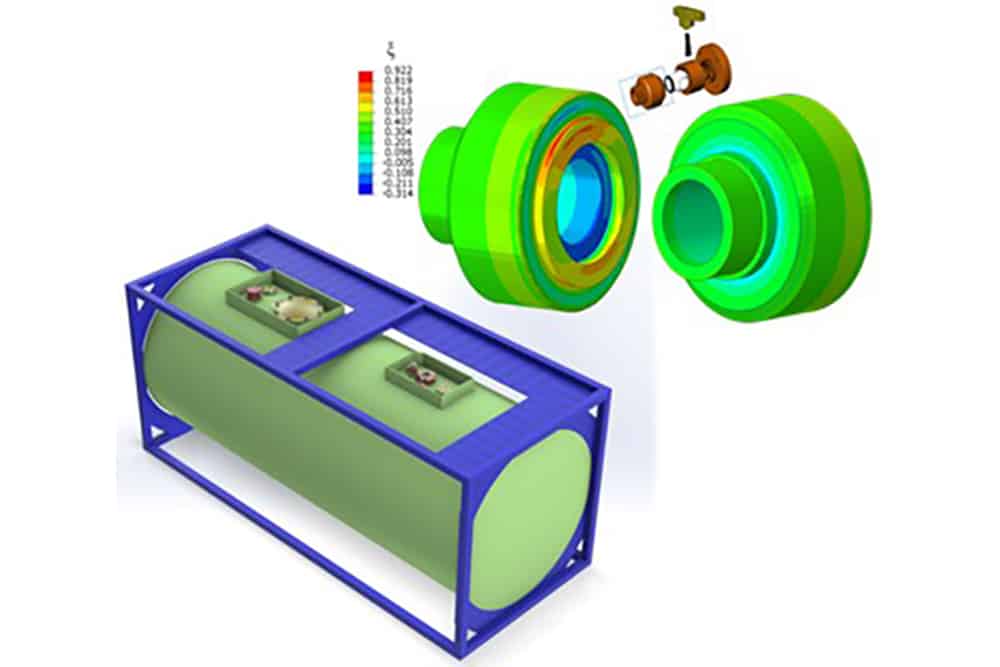
[Image above] Researchers in Russia used constitutive relations to model short-fiber thermoplastic composites designed as shut-off valves for pressure vessel service equipment. Credit: Skolkovo Institute of Science and Technology
In the 10 years since the launch of the Materials Genome Initiative, significantly more researchers are using digital databases and computational tools to aid in materials design, as good models can reduce the number of expensive experiments needed to develop a new product.
For some materials such as piezoelectric ceramics, there are well-established frameworks and techniques for modeling the materials. For other materials, however, researchers face challenges in developing accurate models.
Fiber-reinforced polymer composites are one type of material that is difficult to model. These composites are increasingly used in the construction industry due to their durability and light weight, yet modeling the mechanical behavior is difficult because “these composites show deformation and strength characteristics that are dependent on the loading conditions,” researchers write in a recent paper.
The researchers are led by the Skolkovo Institute of Science and Technology and include colleagues from Lomonosov Moscow State University and Constanta-2 Ltd. In their paper, they propose using constitutive relations to capture the nonlinear elastic and elastoplastic deformation of polymer composites.
A constitutive relation is an equation that describes the relationship between two physical quantities of a material in response to external stimuli. In an email, first author and Skoltech assistant professor Ivan Sergeichev explains why these relations do well in accounting for the polymer composite’s nonlinear response.
“With a good approximation, thermoplastic composites chaotically reinforced with short fibers can in most cases be considered quasi-isotropic materials [having the same value for a physical property when it is measured in-plane in different directions]. This makes it possible not to take into account the structural features of these materials, but to analyze only their macromechanical behavior,” he explains.
“Therefore, after carrying out a series of standard mechanical tests for tension, compression, shear, and bending, it is already possible to obtain the necessary data set for constructing and verifying the constitutive relations for the elastoplastic behavior of these materials. Thereby, making it possible to accept these constitutive relations for the computational design of real full-scale structures,” he adds.
Research on constitutive relations for polymer composites has developed rapidly in recent decades, with many original and review papers published by authors from leading scientific institutions worldwide. Nevertheless, further research is required to continue advancing this field of study for specific industrial applications, and that is what the researchers of the recent paper aimed to do.
They chose to focus on modeling polymer composites designed as shut-off valves for pressure vessel service equipment. They created the short-fiber thermoplastic composites via injection molding and then used test results for tension, compression, and shear to determine the model parameters. They also performed a three-point bending test for model verification.
Based on the tests, “The developed model makes it possible to significantly reduce the conservatism of strength calculations in the design and customization of structures, which means to minimize subsequent manufacturing costs, while fulfilling the necessary safety and quality requirements,” Sergeichev says in a Skoltech press release.
Sergeichev adds in an email that they plan to further extend and develop the methodology of constitutive relations to various types of composite materials, focusing on specific problems for industrial applications.
“This will require complex experimental studies of the behavior of materials under conditions of combined loading, for example, biaxial tension-compression. This, in turn, will require the development of appropriate test methods and the development of experimental facilities,” he says.
The paper, published in International Journal of Pressure Vessels and Piping, is “Constitutive material model for the design and virtual testing of pressure vessel service equipment manufactured from thermoplastic fiber-reinforced polymer composites” (DOI: 10.1016/j.ijpvp.2021.104475).
Author
Lisa McDonald
CTT Categories
- Construction
- Modeling & Simulation
Related Posts
The urban fabric of brick—Part 3: Innovations and the future of design
November 11, 2025
The urban fabric of brick—Part 2: Ancient brick history
October 28, 2025


